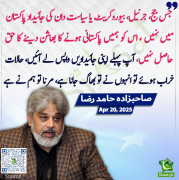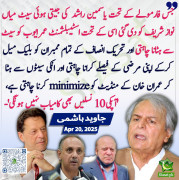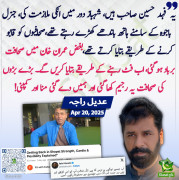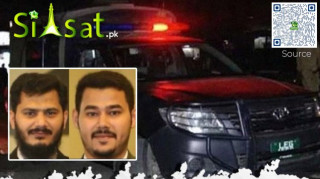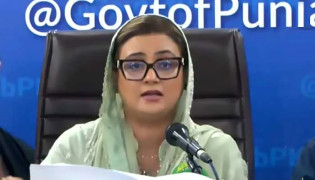You are using an out of date browser. It may not display this or other websites correctly.
You should upgrade or use an alternative browser.
You should upgrade or use an alternative browser.
پاک فوج جرآت،عظمت اور بہادری کی نشانی -- پاک فوج تجھے سلام
- Thread starter IJAZ JUNEJO
- Start date
Wake up Pak
(50k+ posts) بابائے فورم
IJAZ JUNEJO
MPA (400+ posts)
IJAZ JUNEJO
MPA (400+ posts)
IJAZ JUNEJO
MPA (400+ posts)

IJAZ JUNEJO
MPA (400+ posts)

IJAZ JUNEJO
MPA (400+ posts)
In clouds of dust, Pakistani tank and infantry soldiers are moving forward to join the action.

بنگالی تھا اسی لئے حلالی تھاwas MM Alam punjabi?
IJAZ JUNEJO Jin say pesay leta hai un ki marketing tou karay ga. Bechara Interpass na parha na likha, jo tujhay whatsapp pe hukam aa gaya woh post kar dea.










INTER PASSS - INTER PASS - 2nd DIVISION
INTER PASSS - INTER PASS - 2nd DIVISION
3rd_Umpire
Chief Minister (5k+ posts)
بدبُودار سڑی ہوئی پھدی والی رنڈی کی اولاد ایم ایم عالم بنگالی تھا،،، اور پھوجی حرامزادوں نے مرتے دم تک بولنے پر پابندی لگائی تھیBattle of Chumb (1965)

جنگ کے ہیرو ایم ایم عالم
پاکستان کی تاریخ کے دو دیانتدار جج بھگوان داس، اور دُراب پٹیل بھی غیر مسلم ھندو تھے
Tyrion Lannister
Chief Minister (5k+ posts)
junaid safdar asal Id se aif it wasnt for Pak Military, Aleema Khan would be Radha Kumari today and probably grand mother of ek hindustani
wasiqjaved
Chief Minister (5k+ posts)
پاک فوج جرآت،عظمت اور بہادری کی نشانی -- پاک فوج تجھے سلام
آرمی چیف سید عاصم منیر چسکی جب بیٹھ کر استنجا کرتے ہیں تو انکے ٹٹے مبارک کے اوپر سے چشمہ مبارک پھوٹ پڑتا ہے اور یہ کامل لوگوں کی نشانیاں ہوتی ہے ۔
سیاست ڈاٹ پی کے سینئیر دلال و چوپا کار ایجاز جونیجو کا آنکھو دیکھا حال
سیاست ڈاٹ پی کے سینئیر دلال و چوپا کار ایجاز جونیجو کا آنکھو دیکھا حال
Citizen X
(50k+ posts) بابائے فورم
پاک فوج جرآت،عظمت اور بہادری کی نشانی -- پاک فوج تجھے سلام --- جنگ ستمبر 1965 کی یادیں
Battle of Chumb (1965)
The Battle of Chumb was a major battle fought in the early stages of the Indo-Pakistani War of 1965, during Operation Grand Slam. After brief but fierce fighting, the battle culminated in a decisive victory for Pakistan, and the Indian Army retreated with heavy losses.
Background
In May 1965, Pakistan Army drew up plans for an offensive operation to capture the crucial city of Akhnoor in Indian Kashmir,[5] with the aim of severing India's supply lines to Jammu and bringing it to the negotiating table. This operation was dubbed Operation Grand Slam and launched on September 1, 1965, when the Pakistan Army attacked the Chamb sector in the vicinity of Akhnoor. The Pakistani force consisted of 8 infantry battalions, 6 tank squadrons, and 18 artillery batteries, and were commanded by Akhtar Hussain Malik. Indian forces in the region were out-numbered (with only 4 infantry battalions, 1 tank squadron and 3 artillery batteries) and possessed inferior equipment.[2]
Battle
On September 1, 1965, at about 0330 hours, Pakistan launched artillery strikes on Indian positions at Chamb, Dewa, Mandiala, Munawar and Borjeal, carried out by 9 field, 7 medium and 2 heavy artillery batteries. These strikes lasted till about 0500 hours, when Operation Grand Slam fully commenced and a sizable Pakistani force crossed the line of control, consisting of 8 infantry battalions, 6 tank squadrons and 18 artillery batteries (the numerical equivalent of roughly 8,000 soldiers, 90-100 tanks and 100-120 artillery guns).[2]
Skirmish at Borjeal
Borjeal, sometimes known as Borajal, was an Indian fortification located on the Line of Control along Azad Kashmir. At an altitude of about 950 feet, it provided a clear view of the Pakistani side. The position consisted of pillboxes arranged in a semi-circle formation, which were connected to each other by underground tunnels. The position was defended by 2 companies of India's 6th Sikh regiment.[2]
Half of Pakistan's 102 Brigade and a squadron of 13 Lancers attacked Borjeal, despite initial plans to bypass the position. The position was overwhelmed within hours despite being well-defended. 14 Indian soldiers were captured in the skirmish, and an unknown number more were killed.[2] Following victory at Borjeal, Pakistan advanced to the city of Chamb.
Fall of Chamb
The terrain around Chamb was uneven, with a number of ridges and streams that made advances difficult for large armored formations. This benefited the thinly-stretched defenders, who in some cases were able to effectively engage Pakistani tanks such as near the Tawi stream.[2] However, this ultimately failed to curb the Pakistani advance. The Indian forces in the area were outnumbered, possessing only 4 infantry battalions, 1 tank squadron and 3 artillery batteries (about 4,000 men, 15-20 tanks and 20 artillery guns). Additionally the Pakistanis possessed superior equipment in the form of American-made M47 Patton and M48 Patton tanks, which far outclassed the French-made AMX-13 light tanks used by the Indians. Pakistan's 8-inch Howitzers were also superior to anything in Indian use at the time. According to Pakistani military historian Major (retd.) A. H. Amin, the Indian AMX-13 tanks were like 'matchboxes' in front of the Pakistani Pattons.[2] The Indian forces at Chamb and surrounding areas put up some resistance initially, but were defeated by the Pakistanis after brief but fierce fighting. India's defenses had been caught off-guard, and the Pakistan Army, with its superior equipment, tactics and training, made steady gains. Offensive maneuvers cut off or strained most of India's supply lines in the area. At last, having suffered heavy losses and unable to reinforce their positions, the Indians retreated and the region came under Pakistani control.[2] Roughly 288 square kilometers (111 square miles) in and around Chamb were captured by Pakistan.[6]
Aerial Combat
On 1 September, the No. 45 Squadron of Indian Air Force carried out airstrikes on the advancing Pakistanis using 12 De Havilland Vampire aircraft. While these strikes were somewhat successful in slowing down their advance, the Pakistanis quickly requested aerial assistance. Two F-86 Sabres of the No. 7 Squadron of the Pakistan Air Force engaged the Vampires.[7] In the resulting dogfight, 4 Vampires were shot down, including 3 by the Sabres and 1 by ground fire,[8]while Pakistan lost none of their aircraft. These losses resulted in the Vampires eventually being retired from service by the Indian Air Force.
Casualties
Indian losses at Chumb were heavy; with 212 killed and 49 captured (14 at Borajal and 35 at Chumb).[3] Their only tank battalion in the area was annihilated,[9] with 8 tanks destroyed and a dozen tanks captured in operational condition (later used by Pakistan against India). 7 artillery guns were also destroyed and 13 more captured,[4] one of which was named 'Chamb di Rani' (Queen of Chamb) by the Pakistani forces. This gun was reportedly used by the Pakistanis against India later in the war. India also lost 4 Vampire fighter jets to Pakistani F-86 Sabres in the aerial clashes above Chamb.[8] Pakistani losses stood at 75 killed, 2 tanks destroyed and 4 artillery guns lost.
Gallantry Awards
General Akhtar Hussain Malik was awarded the Hilal-i-Jur'at, Pakistan's second-highest military honor, for his valiant leadership and performance during the battle


Battle of Chumb (1965) - Wikipedia
en.wikipedia.org

پاک فوج جرآت،عظمت اور بہادری کی نشانی -- پاک فوج تجھے سلام --- جنگ ستمبر 1965 کی یادیں
Battle of Chumb (1965)
The Battle of Chumb was a major battle fought in the early stages of the Indo-Pakistani War of 1965, during Operation Grand Slam. After brief but fierce fighting, the battle culminated in a decisive victory for Pakistan, and the Indian Army retreated with heavy losses.
Background
In May 1965, Pakistan Army drew up plans for an offensive operation to capture the crucial city of Akhnoor in Indian Kashmir,[5] with the aim of severing India's supply lines to Jammu and bringing it to the negotiating table. This operation was dubbed Operation Grand Slam and launched on September 1, 1965, when the Pakistan Army attacked the Chamb sector in the vicinity of Akhnoor. The Pakistani force consisted of 8 infantry battalions, 6 tank squadrons, and 18 artillery batteries, and were commanded by Akhtar Hussain Malik. Indian forces in the region were out-numbered (with only 4 infantry battalions, 1 tank squadron and 3 artillery batteries) and possessed inferior equipment.[2]
Battle
On September 1, 1965, at about 0330 hours, Pakistan launched artillery strikes on Indian positions at Chamb, Dewa, Mandiala, Munawar and Borjeal, carried out by 9 field, 7 medium and 2 heavy artillery batteries. These strikes lasted till about 0500 hours, when Operation Grand Slam fully commenced and a sizable Pakistani force crossed the line of control, consisting of 8 infantry battalions, 6 tank squadrons and 18 artillery batteries (the numerical equivalent of roughly 8,000 soldiers, 90-100 tanks and 100-120 artillery guns).[2]
Skirmish at Borjeal
Borjeal, sometimes known as Borajal, was an Indian fortification located on the Line of Control along Azad Kashmir. At an altitude of about 950 feet, it provided a clear view of the Pakistani side. The position consisted of pillboxes arranged in a semi-circle formation, which were connected to each other by underground tunnels. The position was defended by 2 companies of India's 6th Sikh regiment.[2]
Half of Pakistan's 102 Brigade and a squadron of 13 Lancers attacked Borjeal, despite initial plans to bypass the position. The position was overwhelmed within hours despite being well-defended. 14 Indian soldiers were captured in the skirmish, and an unknown number more were killed.[2] Following victory at Borjeal, Pakistan advanced to the city of Chamb.
Fall of Chamb
The terrain around Chamb was uneven, with a number of ridges and streams that made advances difficult for large armored formations. This benefited the thinly-stretched defenders, who in some cases were able to effectively engage Pakistani tanks such as near the Tawi stream.[2] However, this ultimately failed to curb the Pakistani advance. The Indian forces in the area were outnumbered, possessing only 4 infantry battalions, 1 tank squadron and 3 artillery batteries (about 4,000 men, 15-20 tanks and 20 artillery guns). Additionally the Pakistanis possessed superior equipment in the form of American-made M47 Patton and M48 Patton tanks, which far outclassed the French-made AMX-13 light tanks used by the Indians. Pakistan's 8-inch Howitzers were also superior to anything in Indian use at the time. According to Pakistani military historian Major (retd.) A. H. Amin, the Indian AMX-13 tanks were like 'matchboxes' in front of the Pakistani Pattons.[2] The Indian forces at Chamb and surrounding areas put up some resistance initially, but were defeated by the Pakistanis after brief but fierce fighting. India's defenses had been caught off-guard, and the Pakistan Army, with its superior equipment, tactics and training, made steady gains. Offensive maneuvers cut off or strained most of India's supply lines in the area. At last, having suffered heavy losses and unable to reinforce their positions, the Indians retreated and the region came under Pakistani control.[2] Roughly 288 square kilometers (111 square miles) in and around Chamb were captured by Pakistan.[6]
Aerial Combat
On 1 September, the No. 45 Squadron of Indian Air Force carried out airstrikes on the advancing Pakistanis using 12 De Havilland Vampire aircraft. While these strikes were somewhat successful in slowing down their advance, the Pakistanis quickly requested aerial assistance. Two F-86 Sabres of the No. 7 Squadron of the Pakistan Air Force engaged the Vampires.[7] In the resulting dogfight, 4 Vampires were shot down, including 3 by the Sabres and 1 by ground fire,[8]while Pakistan lost none of their aircraft. These losses resulted in the Vampires eventually being retired from service by the Indian Air Force.
Casualties
Indian losses at Chumb were heavy; with 212 killed and 49 captured (14 at Borajal and 35 at Chumb).[3] Their only tank battalion in the area was annihilated,[9] with 8 tanks destroyed and a dozen tanks captured in operational condition (later used by Pakistan against India). 7 artillery guns were also destroyed and 13 more captured,[4] one of which was named 'Chamb di Rani' (Queen of Chamb) by the Pakistani forces. This gun was reportedly used by the Pakistanis against India later in the war. India also lost 4 Vampire fighter jets to Pakistani F-86 Sabres in the aerial clashes above Chamb.[8] Pakistani losses stood at 75 killed, 2 tanks destroyed and 4 artillery guns lost.
Gallantry Awards
General Akhtar Hussain Malik was awarded the Hilal-i-Jur'at, Pakistan's second-highest military honor, for his valiant leadership and performance during the battle


Battle of Chumb (1965) - Wikipedia
en.wikipedia.org
اب تو اس پاک بوجھ کے قصے کہانیاں سن کر ہنسی اری ہےاور یہ ایف اے پاس ڈفر، اب بھی اپنی جھوٹی کہانیاں بندوق کے زور پر قوم کو سنانے پر مضر ہیں۔
KamaalKhan
Citizen
زمانہ جاہلیت میں ہم بھی سینہ ٹھوک کر ان افسانوں پر نعرے بازی کیا کرتے تھے۔ اب اپنے آپ پر ہنسی آتی ہے


میدانِ جنگ میں پتلونیں اتارنے والے بزدل گانڈؤں کو ہم نے ٹیپو سلطان اور صلاح الدین ایوبی ثابت کرنے کی کوشش کی۔ یا اللہ ہمارا یہ گناہ معاف کردے
میدانِ جنگ میں پتلونیں اتارنے والے بزدل گانڈؤں کو ہم نے ٹیپو سلطان اور صلاح الدین ایوبی ثابت کرنے کی کوشش کی۔ یا اللہ ہمارا یہ گناہ معاف کردے
Captain Safdar
Chief Minister (5k+ posts)
Chall oye Ph** dia... pehlay apnay pio Khwaha asif naal mushwara tay ker lainda.... he said otherwise.
Ajj kall tawaday moon vich Hafiz da Lor** a... Jay kall nu kisay hor de govt aa gayee tay tusi BC nay aisay hafiz day lor** tay dandi wadd lainee a..
Ajj kall tawaday moon vich Hafiz da Lor** a... Jay kall nu kisay hor de govt aa gayee tay tusi BC nay aisay hafiz day lor** tay dandi wadd lainee a..
digitalzygot1
Minister (2k+ posts)
Fauj tu hamari apni hay we love it but rogue corrupt generals who sold their country for $$$ must be held accountableپاک فوج جرآت،عظمت اور بہادری کی نشانی -- پاک فوج تجھے سلام --- جنگ ستمبر 1965 کی یادیں
Battle of Chumb (1965)
The Battle of Chumb was a major battle fought in the early stages of the Indo-Pakistani War of 1965, during Operation Grand Slam. After brief but fierce fighting, the battle culminated in a decisive victory for Pakistan, and the Indian Army retreated with heavy losses.
Background
In May 1965, Pakistan Army drew up plans for an offensive operation to capture the crucial city of Akhnoor in Indian Kashmir,[5] with the aim of severing India's supply lines to Jammu and bringing it to the negotiating table. This operation was dubbed Operation Grand Slam and launched on September 1, 1965, when the Pakistan Army attacked the Chamb sector in the vicinity of Akhnoor. The Pakistani force consisted of 8 infantry battalions, 6 tank squadrons, and 18 artillery batteries, and were commanded by Akhtar Hussain Malik. Indian forces in the region were out-numbered (with only 4 infantry battalions, 1 tank squadron and 3 artillery batteries) and possessed inferior equipment.[2]
Battle
On September 1, 1965, at about 0330 hours, Pakistan launched artillery strikes on Indian positions at Chamb, Dewa, Mandiala, Munawar and Borjeal, carried out by 9 field, 7 medium and 2 heavy artillery batteries. These strikes lasted till about 0500 hours, when Operation Grand Slam fully commenced and a sizable Pakistani force crossed the line of control, consisting of 8 infantry battalions, 6 tank squadrons and 18 artillery batteries (the numerical equivalent of roughly 8,000 soldiers, 90-100 tanks and 100-120 artillery guns).[2]
Skirmish at Borjeal
Borjeal, sometimes known as Borajal, was an Indian fortification located on the Line of Control along Azad Kashmir. At an altitude of about 950 feet, it provided a clear view of the Pakistani side. The position consisted of pillboxes arranged in a semi-circle formation, which were connected to each other by underground tunnels. The position was defended by 2 companies of India's 6th Sikh regiment.[2]
Half of Pakistan's 102 Brigade and a squadron of 13 Lancers attacked Borjeal, despite initial plans to bypass the position. The position was overwhelmed within hours despite being well-defended. 14 Indian soldiers were captured in the skirmish, and an unknown number more were killed.[2] Following victory at Borjeal, Pakistan advanced to the city of Chamb.
Fall of Chamb
The terrain around Chamb was uneven, with a number of ridges and streams that made advances difficult for large armored formations. This benefited the thinly-stretched defenders, who in some cases were able to effectively engage Pakistani tanks such as near the Tawi stream.[2] However, this ultimately failed to curb the Pakistani advance. The Indian forces in the area were outnumbered, possessing only 4 infantry battalions, 1 tank squadron and 3 artillery batteries (about 4,000 men, 15-20 tanks and 20 artillery guns). Additionally the Pakistanis possessed superior equipment in the form of American-made M47 Patton and M48 Patton tanks, which far outclassed the French-made AMX-13 light tanks used by the Indians. Pakistan's 8-inch Howitzers were also superior to anything in Indian use at the time. According to Pakistani military historian Major (retd.) A. H. Amin, the Indian AMX-13 tanks were like 'matchboxes' in front of the Pakistani Pattons.[2] The Indian forces at Chamb and surrounding areas put up some resistance initially, but were defeated by the Pakistanis after brief but fierce fighting. India's defenses had been caught off-guard, and the Pakistan Army, with its superior equipment, tactics and training, made steady gains. Offensive maneuvers cut off or strained most of India's supply lines in the area. At last, having suffered heavy losses and unable to reinforce their positions, the Indians retreated and the region came under Pakistani control.[2] Roughly 288 square kilometers (111 square miles) in and around Chamb were captured by Pakistan.[6]
Aerial Combat
On 1 September, the No. 45 Squadron of Indian Air Force carried out airstrikes on the advancing Pakistanis using 12 De Havilland Vampire aircraft. While these strikes were somewhat successful in slowing down their advance, the Pakistanis quickly requested aerial assistance. Two F-86 Sabres of the No. 7 Squadron of the Pakistan Air Force engaged the Vampires.[7] In the resulting dogfight, 4 Vampires were shot down, including 3 by the Sabres and 1 by ground fire,[8]while Pakistan lost none of their aircraft. These losses resulted in the Vampires eventually being retired from service by the Indian Air Force.
Casualties
Indian losses at Chumb were heavy; with 212 killed and 49 captured (14 at Borajal and 35 at Chumb).[3] Their only tank battalion in the area was annihilated,[9] with 8 tanks destroyed and a dozen tanks captured in operational condition (later used by Pakistan against India). 7 artillery guns were also destroyed and 13 more captured,[4] one of which was named 'Chamb di Rani' (Queen of Chamb) by the Pakistani forces. This gun was reportedly used by the Pakistanis against India later in the war. India also lost 4 Vampire fighter jets to Pakistani F-86 Sabres in the aerial clashes above Chamb.[8] Pakistani losses stood at 75 killed, 2 tanks destroyed and 4 artillery guns lost.
Gallantry Awards
General Akhtar Hussain Malik was awarded the Hilal-i-Jur'at, Pakistan's second-highest military honor, for his valiant leadership and performance during the battle


Battle of Chumb (1965) - Wikipedia
en.wikipedia.org
-
-
-
-
بڑے بڑوں کی صحافت یہ رجیم کھا گئی
6 | FORUM -
ریاست طیبہ ہے یا ریاست مدینہ
1 | FORUM
-
-
© Copyrights 2008 - 2025 Siasat.pk - All Rights Reserved. Privacy Policy | Disclaimer|




